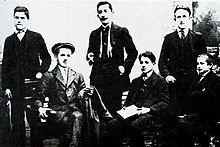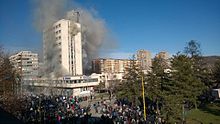Anarchism in Bosnia and Herzegovina first emerged from left-wing currents of the anti-imperialist movement, gaining traction as a tendency in the revolutionary organization Young Bosnia. Following assassination of Archduke Franz Ferdinand and World War I, Bosnia and Herzegovina was brought under a series of authoritarian regimes, before gaining independence in 1992. In the post-independence climate of rising nationalism and income inequality, anarchism re-emerged as part of the nascent anti-nationalist and anti-capitalist movements of the 21st century.
History
Anti-imperialist movement
Anarchism first emerged in the country from left-wing currents during the Herzegovina uprising against the Ottoman Empire in 1875. This movement was spearheaded by the socialist Vladimir Gaćinović and received support from Bosnian and Italian anarchists, including Errico Malatesta.

The subsequent establishment of Austro-Hungarian rule over Bosnia and Herzegovina eventually reached its apex with the country's formal annexation in 1908. Meanwhile, the May Coup in Kingdom of Serbia had led to a rise in Yugoslav nationalism in the Balkans. This culminated with the establishment of Young Bosnia, a revolutionary organization dedicated to the unification of Bosnia and Herzegovina with Serbia. The group's ideological leader was Vladimir Gaćinović, who was inspired by anarchists of the Russian diaspora, including the works of Mikhail Bakunin and Peter Kropotkin, as well as the actions of the Narodnaya Volya organization. He proposed propaganda of the deed in the form of tyrannicide, as a method of revolutionary political struggle to achieve Bosnian national liberation. These ideas were first put into practice by Bogdan Žerajić, himself also a supporter of Kropotkin's ideas, who attempted to assassinate the Governor of Bosnia and Herzegovina Marijan Varešanin, but failed and subsequently committed suicide.
Žerajić's example was followed by several more attempted assassinations of Austro-Hungarian officials, the most significant of which was the assassination of Archduke Franz Ferdinand in Sarajevo. On 28 June 1914, members of Young Bosnia stationed themselves along the route of Franz Ferdinand's motorcade and one by one attempted on his life. The first attempt was by the Bosnian anarcho-syndicalist Nedeljko Čabrinović, who threw a bomb at the Archduke's vehicle, but it failed to detonate in time and Čabrinović's suicide attempt also failed. Despite Čabrinović's failure, one of the Bosnian militants was successful - Gavrilo Princip shot the Archduke and his wife with a revolver, killing both. At their trial, the Young Bosnians declared that the assassination was a reflection of their anarchist beliefs. Čabrinović and Princip were both sentenced to 20 years in prison, but the fallout from the assassination had already led directly to the beginning of World War I. In prison, the German psychologist Martin Pappenheim interviewed Princip about what drove him to assassinate the Archduke. Among the assassin's literature included a variety of anarchist works, including Kropotkin's The Conquest of Bread. Princip and Čabrinović both died in prison from their illnesses, shortly before the war drew to an end.
Yugoslavia
Following the end of World War I, Bosnia and Herzegovina was unified into the Kingdom of Yugoslavia, which ruled as a right-wing dictatorship until the outbreak of World War II. Bosnia and Herzegovina was then brought under the totalitarian rule of the fascist Ustaše, which pursued a campaign of genocide against the country's Serbian, Jewish and Romani people, as well as anti-fascist or dissident Croats and Bosniaks. This was resisted by the Yugoslav Partisans, who following their victory established the Socialist Federal Republic of Yugoslavia and brought the country under the control of the Communist Party. Despite repressions against dissident workers, by the 1950s, many workers managed to implement a system of socialist self-management, which the state allowed in a limited form.
Post-independence

The death of Tito and the subsequent breakup of Yugoslavia led to an armed conflict in the newly independent Republic of Bosnia and Herzegovina. The Dayton Agreement which ended the war partitioned the state between two federal entities: the Federation of Bosnia and Herzegovina and the Republika Srpska. The country was thus completely divided along ethnic lines, exacerbating the rise of nationalism and income inequality.
Following the outbreak of the Bosnian War, the city of Tuzla found itself under siege by the Republik Srpska, preventing food and fuel from entering the city. In December 1993, Swedish anarchist Eva X Moberg led a campaign by International Workers Aid (IWA) to transport supplies to Tuzla, organising a "Labour Convoy" (Swedish: Arbetarkonvojen) with the aid of unions from several different countries. They quickly hit administrative hurdles, as Swedish NGOS insisted that the IWA unload its supplies at the UNHCR warehouse "like everybody else". They refused, as they wanted to establish direct contact with the people that would be receiving the supplies. Moberg travelled to Tuzla several times, later reporting that the IWA organised 30 supply convoys during the course of the war. During this time, she wrote a column for Aftonbladet, in which she publicised the situation in Bosnia to Swedish readers and raised the IWA's own profile in the process. By the end of Yugoslav Wars, the IWA's presence in Tuzla wound to a close.
This new status quo once again gave rise to anarchism within the country, after having been suppressed for nearly a century of authoritarian rule by various different parties. The rise of the Dosta movement from internet forums to public meetings brought about a form of libertarian organizing that transcended ethnic divisions. As it grew, it began to confront social and economic issues, even beginning to take direct action themselves. After the Financial crisis of 2007–2008, a method of organizing around direct democratic assemblies known as plenums. These plenums were one of the primary modes of organizing during the 2014 unrest in Bosnia and Herzegovina, in which anarchists participated. The protests took on a fundamentally anti-nationalist character, with the slogan "Death to nationalism!" being graffiti'd on the walls of Sarajevo.
On 19 May 2020, Bosnian anarchist and anti-fascist activist Haris Pendić was arrested for publishing a YouTube video in which he, using extremely harsh language, denounced Bosnia's leading Catholic Church figure, Archbishop of Vrhbosna Cardinal Vinko Puljić. Pendić was motivated to produce such a video by Archbishop's decision to hold a memorial Mass for executed soldiers of the pro-Nazi Independent State of Croatia, an act which was strongly condemned by the Bosnian public as an attempt of historical revisionism and rehabilitation of Ustashas and Nazism. Subsequent public debate on the video triggered even stronger verbal clashes between Haris Pendić and Croat and Bosniak nationalists and led to Pendić's two further arrests.
See also
- Category:Bosnia and Herzegovina anarchists
- List of anarchist movements by region
- Anarchism in Croatia
- Anarchism in Serbia
- Young Bosnia
- 2014 unrest in Bosnia and Herzegovina
References
- ^ Indic, Trivo (27 May 1990). "The anarchist tradition on Yugoslav soil". Umanità Nova. Retrieved 17 October 2014.
- Belgrade (Serbia). Vojni muzej Jugoslovenske narodne armije (1968). Fourteen centuries of struggle for freedom. The Military Museum. p. li.
- Лесковац, Младен; Форишковић, Александар; Попов, Чедомир (2004). Српски биографски речник (in Serbian). Будућност. p. 634. ISBN 9788683651627.
- Мастиловић, Драга (2009). Херцеговина у Краљевини Срба, Хрвата и Словенаца: 1918-1929 (in Serbian). Филип Вишњић. p. 35. ISBN 978-86-7363-604-7.
- Ćorović, Vladimir (1992). Odnosi između Srbije i Austro-Ugarske u XX veku. Biblioteka grada Beograda. p. 624. ISBN 9788671910156.
- Dedijer, Vladimir (1966). The Road to Sarajevo. New York: Simon and Schuster. p. 12. OCLC 400010.
- MacMillan, Margaret (2013). The War That Ended Peace: How Europe Abandoned Peace for the First World War. Profile Books. p. 518. ISBN 9781847654168.
- Owings, W.A. Dolph. (1984). The Sarajevo Trial. Chapel Hill, NC: Documentary Publications. pp. 527–530. ISBN 0-89712-122-8.
- Pappenheim, Martin (1916). "Conversations With Gavrilo Princip".
- "Alexander I | king of Yugoslavia". Encyclopedia Britannica. Retrieved 7 June 2019.
- Payne, Stanley G. (1996). A History of Fascism, 1914–1945. University of Wisconsin Press. p. 325. ISBN 0299148742.
- Fischer, Bernd J., ed. (2007). Balkan Strongmen: Dictators and Authoritarian Rulers of South-Eastern Europe. Purdue University Press. pp. 207–08, 210, 226. ISBN 978-1-55753-455-2.
- Hoare, Marko Attila (2013). The Bosnian Muslims in the Second World War: A History. Oxford University Press. p. 23. ISBN 978-0199327850.
- Simic, Aleksandar (November 1995). "The workers' movement in Serbia and ex-Yugoslavia". Translated by Will Firth. Revolutionary Group TORPEDO. Archived from the original on 30 June 2012.
- ^ "Anarchists in the Bosnian Uprising". CrimethInc. 18 February 2014. Retrieved 26 January 2021.
- Moll, Nicolas (2021). Solidarity is More Than a Slogan: International Workers Aid During and After the 1992–1995 War in Bosnia and Herzegovina (PDF). Rosa Luxemburg Foundation. pp. 23–25, 94–95. Retrieved 4 June 2024.
- Katalenac, Juraj (6 February 2014). "What's up with Bosnia?". Insurgent Notes. Retrieved 26 January 2021.
- Gavroche, Julius (31 March 2014). "All power to the plenums: Bosnia and Herzegovina's insurrection". Autonomies. Retrieved 26 January 2021.
- "Man detained after threatening Bosnia's Archbishop". N1 Sarajevo. 22 January 2021. Retrieved 22 May 2023.
- Hartmann, Graham (22 May 2020). "Axe-Wielding Metalhead YouTuber Arrested for Video Against the Catholic Church". Loudwire. Townsquare Media, Inc. Retrieved 22 May 2023.
- Thalen, Mikael (23 May 2020). "Metalhead YouTuber arrested after criticizing the mourning of executed pro-Nazi militants". Daily Dot. Retrieved 22 May 2023.
| Anarchism by region | |
|---|---|
| Africa | |
| Asia | |
| Europe | |
| North America | |
| Oceania | |
| South America | |
| Individualist anarchism | |
| Anarchism in Europe | |
|---|---|
| Sovereign states |
|
| States with limited recognition | |
| Dependencies and other entities | |
